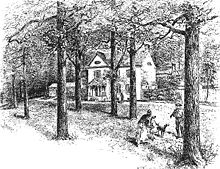James Craik
James Craik (* 1730 in Kirkcudbright , Scotland; † February 6, 1814 in Alexandria , Virginia ) was General Physician (forerunner of the Surgeon General ) of the United States Army and George Washington's personal physician and close friend.
Education and emigration to America
Born in Kirkcudbright, Scotland, Craik was the illegitimate son of Robert Craik, a Member of Parliament. He studied medicine at the University of Edinburgh , then joined the British Army and, after graduating, served as a military doctor in the Caribbean until 1751. Craik then opened a private medical practice in Norfolk , shortly thereafter relocating to Winchester .
French and Indian War
On March 7, 1754, Craik resumed his military career by accepting a position as a surgeon in Colonel Joshua Fry's Virginia Regiment. During this time he became a good friend of George Washington, who was then a lieutenant colonel in the regiment. Craik witnessed a large number of French-Indian War battles . He fought in the Battle of the Great Meadows and took part in the surrender of Fort Necessity . Then he accompanied General Edward Braddock in the unsuccessful attempt to recapture the region until 1755 , finally treating Braddock's fatal wounds. Craik then served under Washington in Virginia and Maryland on various missions against the Indians.
Between the wars
After the war ended, Craik reopened a medical practice in Port Tobacco , Maryland. On November 13, 1760, he married Marianne Ewell, daughter of Captain Charles Ewell of Bel Air in Prince William County , Virginia. Marianne later became the great-aunt of Richard S. Ewell . They had six sons and three daughters. In 1760 he moved to Charles County , Maryland, where he built La Grange near La Plata in 1765 . In 1770 and 1784 he took part in surveying expeditions with Washington to check military claims in Pennsylvania, what is now West Virginia .
Career during the War of Independence
When fighting broke out during the American Revolution, Craik served in the army. He initially served as a military doctor, then rose to the second highest post within the military medical service. Craik warned Washington about the Conway Cabal and treated the wounds of General Hugh Mercer at the Battle of Princeton and Marie-Joseph Motier, Marquis de La Fayette, at the Battle of Brandywine . Mercer died of his wounds, La Fayette was luckier.
Washington persuaded him to move his practice to Alexandria, Virginia, where he built his Vaucluse plantation and eventually died. Also had a town house at 117 South Fairfax Street, 210 Prince Street and then 210 Duke Street. Washington took Craik out of his practice in 1798 in connection with the quasi-war against France, and he became the Army Medical Officer on June 19 . After the end of hostilities, Craik retired on June 15, 1800.
Washington death
As Washington's personal physician, Craik was one of three doctors who were with him on December 14, 1799 during his last illness. Washington complained of breathlessness, Craik described this as "cynanche trachealis". Since Washington was unable to swallow medication, the other two doctors (Dr. Elisa C. Dick and Dr. Gustavus Richard Brown ) treated his condition with bloodletting, various compresses and enemas. Washington's condition continued to deteriorate, but Craik and Brown opted for a tracheostomy (which might have been life-saving but likely caused sepsis ), contrary to Dickss's suggestion , and Washington died at 10:10 that evening. Brown and Craik jointly published an account of their treatment in December 1800. Craik died in Alexandria in 1814 and is buried there in the Presbyterian Old Meeting House cemetery.
swell
- Pilcher, James Evelyn .: The Surgeon Generals of the Army of the United States of America: A Series of Biographical Sketches of the Senior Officers of the Military Medical Service from the American Revolution to the Philippine Pacification (1905) pp. 21-24
- " James Craik, " The United States Office of Medical History, accessed May 20, 2006.
- Custis, George Washington Parke, Recollections of Washington (1860)
- " A Physician Looks At The Death of Washington, " Vibul V. Vadakan, MD, Early American Review , accessed December 20, 2008.
| personal data | |
|---|---|
| SURNAME | Craik, James |
| BRIEF DESCRIPTION | American doctor and friend of George Washington |
| DATE OF BIRTH | 1730 |
| PLACE OF BIRTH | Kirkcudbright , Scotland |
| DATE OF DEATH | February 6, 1814 |
| Place of death | Alexandria , Virginia |

